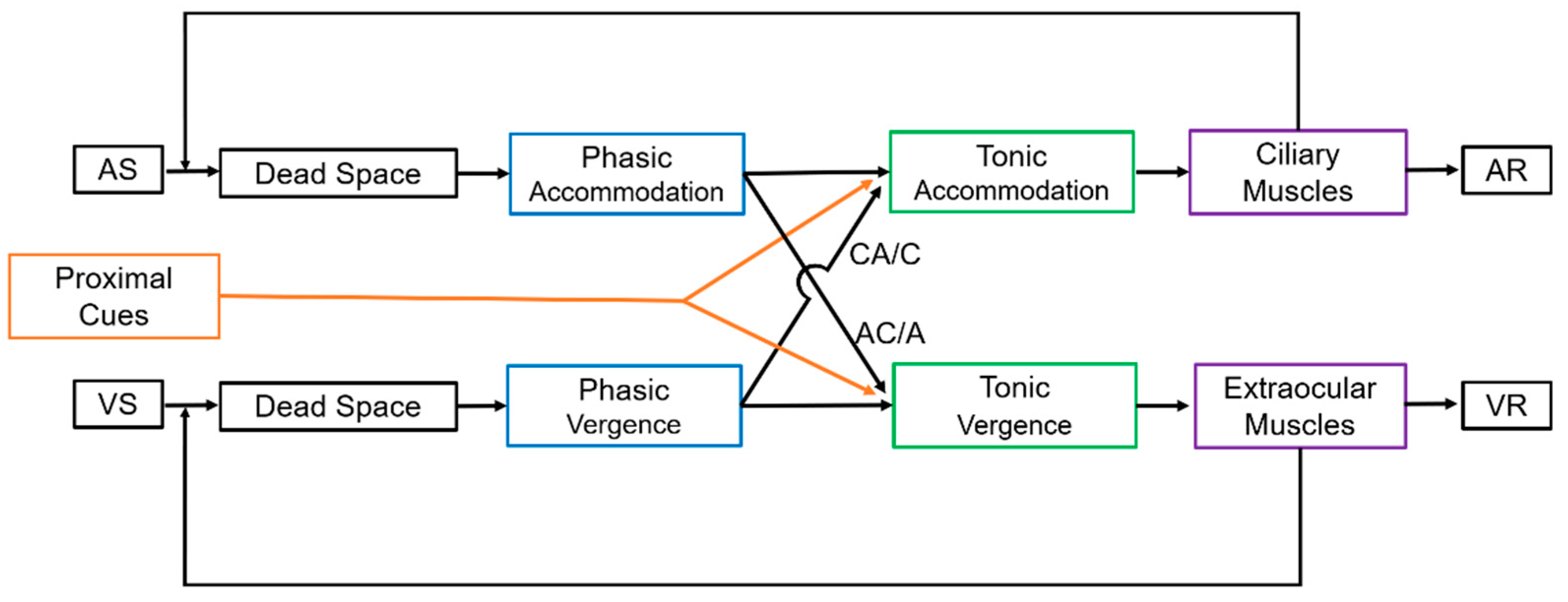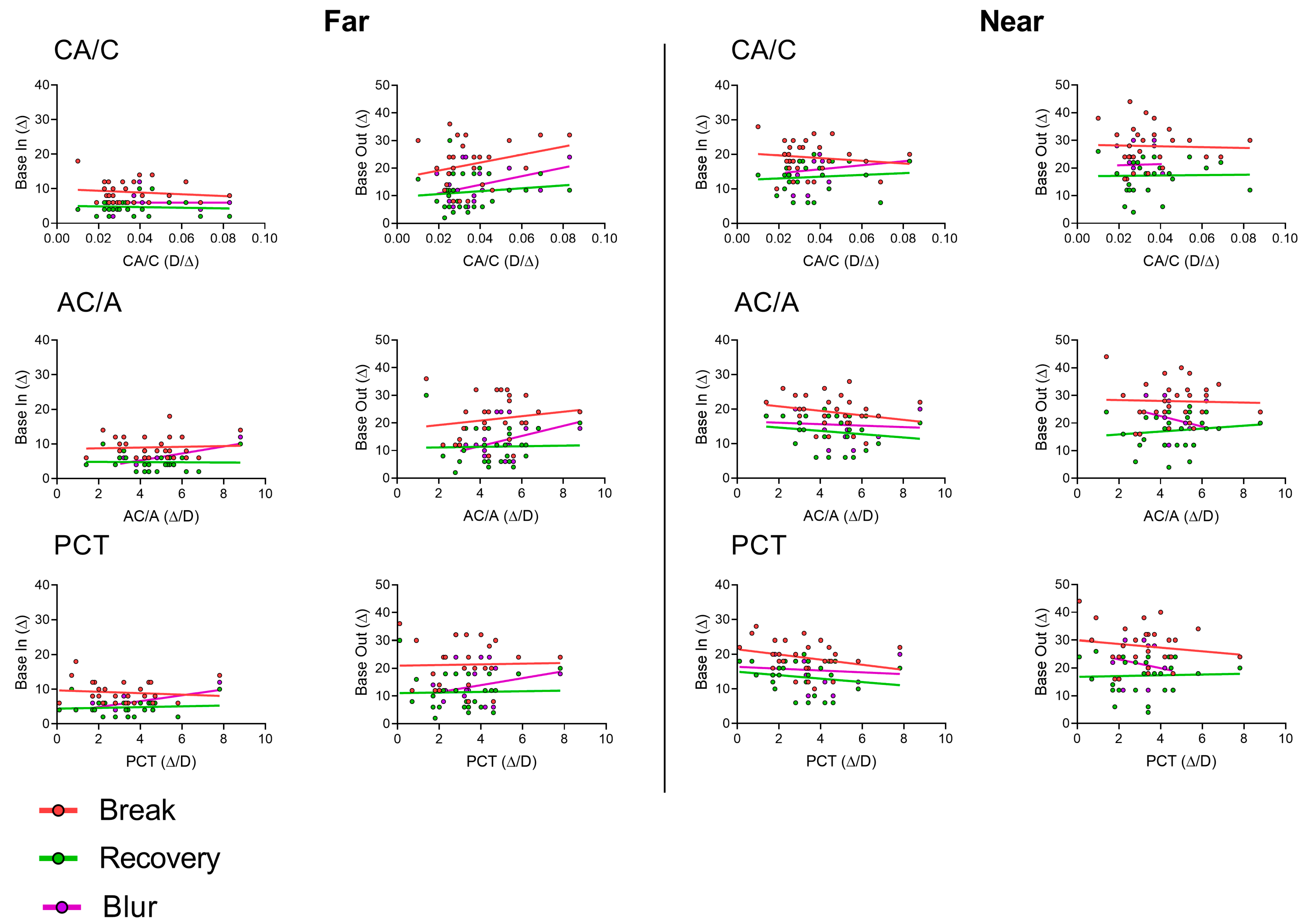The Interaction between Vergence and Accommodation Cues in the Assessment of Fusional Vergence Range
Abstract
1. Introduction
2. Materials and Methods
2.1. Participants Selection
2.2. Fusional Vergence Range, Heterophoria, Near Point of Convergence, and Amplitude of Accommodation
2.3. CA/C Stimulus Ratio
2.4. AC/A Stimulus Ratio
2.5. Proximal Cues (PCT Ratio)
2.6. Data Analysis
3. Results
3.1. Participants and Descriptive Values
3.2. Incidence of Blur Reporting during Fusional Vergence Test
3.3. Correlation between CA/C and AC/A
3.4. Correlations between CA/C, AC/A, and PCT with Break and Recovery Values
3.5. AC/A, CA/C, and PCT Values and the Occurrence of Blur
4. Discussion
Author Contributions
Funding
Institutional Review Board Statement
Informed Consent Statement
Data Availability Statement
Acknowledgments
Conflicts of Interest
References
- Grosvenor, T.; Grosvenor, T.P. Primary Care Optometry; Elsevier Health Sciences: Amsterdam, The Netherlands, 2007. [Google Scholar]
- Rosenfield, M.; Logan, N. Optometry: Science, Techniques and Clinical Management; Elsevier Health Sciences: Amsterdam, The Netherlands, 2009. [Google Scholar]
- Scheiman, M.; Wick, B. Clinical Management of Binocular Vision: Heterophoric, Accommodative, and Eye Movement Disorders; Lippincott Williams & Wilkins: Philadelphia, PA, USA, 2008. [Google Scholar]
- Antona, B.; Barrio, A.; Barra, F.; Gonzalez, E.; Sanchez, I. Repeatability and agreement in the measurement of horizontal fusional vergences. Ophthalmic Physiol. Opt. 2008, 28, 475–491. [Google Scholar] [CrossRef]
- Fray, K.J. Fusional amplitudes: Developing testing standards. Strabismus 2017, 25, 145–155. [Google Scholar] [CrossRef] [PubMed]
- Lança, C.C.; Rowe, F.J. Measurement of fusional vergence: A systematic review. Strabismus 2019, 27, 88–113. [Google Scholar] [CrossRef] [PubMed]
- Palomo Álvarez, C.; Puell, M.C.; Sánchez-Ramos, C.; Villena, C. Normal values of distance heterophoria and fusional vergence ranges and effects of age. Graefes Arch. Clin. Exp. Ophthalmol. 2006, 244, 821–824. [Google Scholar] [CrossRef] [PubMed]
- Rovira-Gay, C.; Mestre, C.; Argiles, M.; Vinuela-Navarro, V.; Pujol, J. Feasibility of measuring fusional vergence amplitudes objectively. PLoS ONE 2023, 18, e0284552. [Google Scholar] [CrossRef]
- Rowe, F.J. Fusional vergence measures and their significance in clinical assessment. Strabismus 2010, 18, 48–57. [Google Scholar] [CrossRef]
- Sreenivasan, V.; Babinsky, E.E.; Wu, Y.; Candy, T.R. Objective measurement of fusional vergence ranges and heterophoria in infants and preschool children. Investig. Opthalmology Vis. Sci. 2016, 57, 2678–2688. [Google Scholar] [CrossRef]
- Moon, B.-Y.; Kim, S.-Y.; Yu, D.-S. Receiver operating characteristic curve analysis of clinical signs for screening of convergence insufficiency in young adults. PLoS ONE 2020, 15, e0228313. [Google Scholar] [CrossRef]
- Hung, S.S.; Fisher, A.G.; Cermak, S.A. The performance of learning-disabled and normal young men on the test of visual-perceptual skills. Am. J. Occup. Ther. 1987, 41, 790–797. [Google Scholar] [CrossRef]
- Hung, G.K. Linear model of accommodation and vergence can account for discrepancies between AC/A measures using the fixation disparity and phoria methods. Ophthalmic Physiol. Opt. 1991, 11, 275–278. [Google Scholar] [CrossRef]
- Hung, G.K. Adaptation model of accommodation and vergence. Ophthalmic Physiol. Opt. 1992, 12, 319–326. [Google Scholar] [CrossRef] [PubMed]
- Hung, G.K.; Ciuffreda, K.J.; Rosenfield, M. Proximal contribution to a linear static model of accommodation and vergence. Ophthalmic Physiol. Opt. 1996, 16, 31–41. [Google Scholar] [CrossRef] [PubMed]
- Gwiazda, J.; Thorn, F.; Held, R. Accommodation, accommodative convergence, and response AC/A ratios before and at the onset of myopia in children. Optom. Vis. Sci. 2005, 82, 273–278. [Google Scholar] [CrossRef]
- Arnoldi, K.A.; Reynolds, J.D. Diagnosis of pseudo-divergence excess exotropia secondary to high accommodative convergence to accommodation ratio. Am. Orthopt. J. 2006, 56, 133–137. [Google Scholar] [CrossRef]
- Brautaset, R.L.; Jennings, A.J.M. Effects of orthoptic treatment on the CA/C and AC/A ratios in convergence insufficiency. Investig. Opthalmology Vis. Sci. 2006, 47, 2876–2880. [Google Scholar] [CrossRef]
- Fukushima, T.; Torii, M.; Ukai, K.; Wolffsohn, J.S.; Gilmartin, B. The relationship between CA/C ratio and individual differences in dynamic accommodative responses while viewing stereoscopic images. J. Vis. 2009, 9, 21. [Google Scholar] [CrossRef] [PubMed]
- Hirani, K.J.; Firth, A.Y. Convergence accommodation to convergence (CA/C) ratio: Stability with different levels of convergence demand. Br. Ir. Orthopt. J. 2009, 6, 60–64. [Google Scholar] [CrossRef][Green Version]
- Neveu, P.; Roumes, C.; Philippe, M.; Fuchs, P.; Priot, A.-E. Stereoscopic viewing can induce changes in the CA/C ratio. Investig. Opthalmology Vis. Sci. 2016, 57, 4321–4326. [Google Scholar] [CrossRef]
- Rosenfield, M.; Gilmartin, B. Assessment of the CA/C ratio in a myopic population. Am. J. Optom. Physiol. Opt. 1988, 65, 168–173. [Google Scholar] [CrossRef] [PubMed]
- Rosenfield, M.; Ciuffreda, K.J.; Chen, H.-W. Effect of age on the interaction between the AC/A and CA/C ratios. Ophthalmic Physiol. Opt. 1995, 15, 451–455. [Google Scholar] [CrossRef]
- Tsuetaki, T.K.; Schor, C.M. Clinical method for measuring adaptation of tonic accommodation and vergence accommodation. Am. J. Optom. Physiol. Opt. 1987, 64, 437–449. [Google Scholar] [CrossRef] [PubMed]
- Horwood, A.M.; Riddell, P.M. The clinical near gradient stimulus AC/A ratio correlates better with the response CA/C ratio than with the response AC/A ratio. Strabismus 2013, 21, 140–144. [Google Scholar] [CrossRef] [PubMed]
- Sweeney, L.E.; Seidel, D.; Day, M.; Gray, L.S. Quantifying interactions between accommodation and vergence in a binocularly normal population. Vis. Res. 2014, 105, 121–129. [Google Scholar] [CrossRef]
- Benjamin, W.J. Borish’s Clinical Refraction; Elsevier Health Sciences: Amsterdam, The Netherlands, 2006. [Google Scholar]
- Horwood, A.M.; Riddell, P.M. The use of cues to convergence and accommodation in naïve, uninstructed participants. Vis. Res. 2008, 48, 1613–1624. [Google Scholar] [CrossRef]
- Horwood, A.M.; Riddell, P.M. Decreased accommodation during decompensation of distance exotropia. Br. J. Ophthalmol. 2012, 96, 508–513. [Google Scholar] [CrossRef] [PubMed]
- Horwood, A.M.; Riddell, P.M. Evidence that convergence rather than accommodation controls intermittent distance exotropia. Acta Ophthalmol. 2012, 90, e109–e117. [Google Scholar] [CrossRef] [PubMed]
- Horwood, A.M.; Riddell, P.M. Accommodation and vergence response gains to different near cues characterize specific esotropias. Strabismus 2013, 21, 155–164. [Google Scholar] [CrossRef]
- Horwood, A.M.; Riddell, P.M. Disparity-driven vs blur-driven models of accommodation and convergence in binocular vision and intermittent strabismus. J. AAPOS 2014, 18, 576–583. [Google Scholar] [CrossRef]
- Mestre, C.; Neupane, S.; Manh, V.; Tarczy-Hornoch, K.; Candy, T.R. Vergence and accommodation responses in the control of intermittent exotropia. Ophthalmic Physiol. Opt. 2023, 43, 598–614. [Google Scholar] [CrossRef]
- Joubert, C.; Bedell, H.E. Proximal vergence and perceived distance. Optom. Vis. Sci. 1990, 67, 29–35. [Google Scholar] [CrossRef]
- Wick, B. Clinical factors in proximal vergence. Am. J. Optom. Physiol. Opt. 1985, 62, 1–18. [Google Scholar] [CrossRef] [PubMed]
- Wick, B.; Bedell, H.E. Magnitude and velocity of proximal vergence. Investig. Opthalmology Vis. Sci. 1989, 30, 755–760. [Google Scholar]
- Fogt, N.; Toole, A.J.; Rogers, D.L. A review of proximal inputs to the near response. Clin. Exp. Optom. 2016, 99, 30–38. [Google Scholar] [CrossRef]
- Fogt, N. Comparisons of proximal vergence measures. Vis. Dev. Rehabil. 2020, 6, 252. [Google Scholar] [PubMed]
- Faul, F.; Erdfelder, E.; Lang, A.-G.; Buchner, A. G* Power 3: A flexible statistical power analysis program for the social, behavioral, and biomedical sciences. Behav. Res. Methods 2007, 39, 175–191. [Google Scholar] [CrossRef]
- Murray, C.; Newsham, D. The normal accommodative convergence/accommodation (AC/A) ratio. J. Binocul. Vis. Ocul. Motil. 2018, 68, 140–147. [Google Scholar] [CrossRef]
- Gwiazda, J.; Grice, K.; Thorn, F. Response AC/A ratios are elevated in myopic children. Ophthalmic Physiol. Opt. 1999, 19, 173–179. [Google Scholar] [CrossRef]
- Bhoola, H.; Bruce, A.S.; Atchison, D.A. Validity of clinical measures of the AC/A ratio. Clin. Exp. Optom. 1995, 78, 3–10. [Google Scholar] [CrossRef]
- Rainey, B.B.; Goss, D.A.; Kidwell, M.; Feng, B. Reliability of the response AC/A ratio determined using nearpoint autorefraction and simultaneous heterophoria measurement. Clin. Exp. Optom. 1998, 81, 185–192. [Google Scholar] [CrossRef] [PubMed]
- Singh, N.K.; Mani, R.; Hussaindeen, J.R. Changes in stimulus and response AC/A ratio with vision therapy in Convergence Insufficiency. J. Optom. 2017, 10, 169–175. [Google Scholar] [CrossRef]


| Far (6.0 m) | Near (0.4 m) | |||||||||||
|---|---|---|---|---|---|---|---|---|---|---|---|---|
| BI | BO | BI | BO | |||||||||
| b | B | r | b | B | r | b | B | r | b | B | r | |
| Median | 6.00 | 8.00 | 4.00 | 12.00 | 20.00 | 12.00 | 18.00 | 20.00 | 14.00 | 21.00 | 28.00 | 18.00 |
| IQR (25%) | 4.00 | 6.00 | 3.50 | 8.00 | 14.00 | 6.00 | 12.00 | 16.00 | 10.00 | 12.00 | 24.00 | 12.00 |
| IQR (75%) | 7.00 | 12.00 | 6.00 | 18.00 | 30.00 | 18.00 | 18.00 | 22.00 | 18.00 | 28.50 | 32.00 | 22.00 |
| Far (6.0 m) | Near (0.4 m) | ||||||
|---|---|---|---|---|---|---|---|
| BI | BO | BI | BO | ||||
| Blur | No blur | Blur | No blur | Blur | No blur | Blur | No blur |
| 10 37.0% | 17 63.0% | 20 74.1% | 7 25.9% | 15 55.5% | 12 44.5% | 10 37.0% | 17 63.0% |
Disclaimer/Publisher’s Note: The statements, opinions and data contained in all publications are solely those of the individual author(s) and contributor(s) and not of MDPI and/or the editor(s). MDPI and/or the editor(s) disclaim responsibility for any injury to people or property resulting from any ideas, methods, instructions or products referred to in the content. |
© 2024 by the authors. Licensee MDPI, Basel, Switzerland. This article is an open access article distributed under the terms and conditions of the Creative Commons Attribution (CC BY) license (https://creativecommons.org/licenses/by/4.0/).
Share and Cite
Argilés, M.; Cardona, G. The Interaction between Vergence and Accommodation Cues in the Assessment of Fusional Vergence Range. Life 2024, 14, 1185. https://doi.org/10.3390/life14091185
Argilés M, Cardona G. The Interaction between Vergence and Accommodation Cues in the Assessment of Fusional Vergence Range. Life. 2024; 14(9):1185. https://doi.org/10.3390/life14091185
Chicago/Turabian StyleArgilés, Marc, and Genis Cardona. 2024. "The Interaction between Vergence and Accommodation Cues in the Assessment of Fusional Vergence Range" Life 14, no. 9: 1185. https://doi.org/10.3390/life14091185
APA StyleArgilés, M., & Cardona, G. (2024). The Interaction between Vergence and Accommodation Cues in the Assessment of Fusional Vergence Range. Life, 14(9), 1185. https://doi.org/10.3390/life14091185





